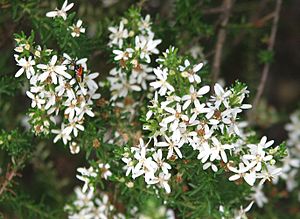Twiggy daisy-bush facts for kids
Quick facts for kids Twiggy daisy-bush |
|
|---|---|
 |
|
| Scientific classification | |
| Kingdom: | |
| (unranked): | |
| (unranked): | |
| (unranked): | |
| Order: | |
| Family: | |
| Tribe: |
Astereae
|
| Genus: |
Olearia
|
| Species: |
O. ramulosa
|
| Binomial name | |
| Olearia ramulosa (Labill.) Benth.
|
|
| Synonyms | |
|
Aster ramulosus Labill. |
|
The twiggy daisy-bush, also known by its scientific name Olearia ramulosa, is a beautiful flowering plant. It belongs to the Asteraceae family, which is also known as the daisy family. You can find this plant growing naturally in different parts of Australia, including New South Wales, Victoria, South Australia, and Tasmania.
Contents
About the Twiggy Daisy-Bush
What Does It Look Like?
The twiggy daisy-bush is a type of shrub that can grow up to 1.6 meters (about 5 feet) tall. Its leaves are narrow and grow one after another along the stems. Each leaf is small, usually 2 to 8 millimeters long and 0.8 to 2.5 millimeters wide. The edges of the leaves are smooth.
The plant gets its name, "twiggy," because it has many small branches. Its scientific name, ramulosa, comes from the Latin word rama, which also means "branch."
When Does It Flower?
The flowers of the twiggy daisy-bush appear from October to May. They look like small daisies and are about 1 to 2 centimeters (less than an inch) wide. Each flower head has 2 to 13 white or light purple petals, called "rays." In the center of the flower, there is a bright yellow disc. When many of these flowers bloom at once, they can be very noticeable and pretty!
Where Does It Grow?
This plant is native to Australia. It can be found in several states, including New South Wales, Victoria, South Australia, and Tasmania. Sometimes, people call it "oily bush" or "water cypress."
Who Discovered It?
A French explorer and botanist named Jacques Labillardière was the first to describe the twiggy daisy-bush. He named it Aster ramulosus in 1806. He wrote about it in his book, Novae Hollandiae Plantarum Specimen, using plants he found in Tasmania. Later, other botanists gave it different scientific names before it became known as Olearia ramulosa.
Plant Life and Animals
The twiggy daisy-bush is an important plant for some animals. For example, caterpillars of a moth species called Amelora milvaria like to eat this plant. Many different insects also visit its flowers. Bees and beetles are often seen on the flowers. Sometimes, flies and wasps also come to visit. These insects help the plant by moving pollen from one flower to another, which helps the plant make seeds.
Growing Your Own Twiggy Daisy-Bush
If you want to grow a twiggy daisy-bush, you can do it in a couple of ways. You can plant seeds, or you can use cuttings from new parts of the plant that have become a bit firm. This plant can grow well in places that are dry or have a mild climate. It can also handle frost, especially if it's in a sunny or partly shaded spot.
If you trim the plant, it can grow back stronger and healthier. You can even prune it to make a low hedge in your garden.

